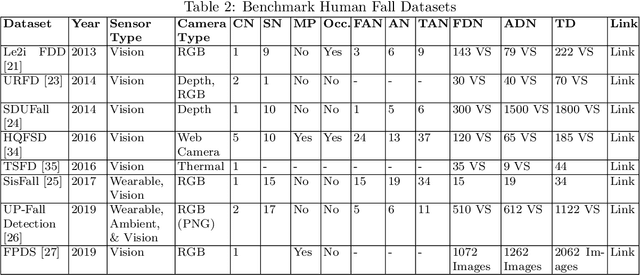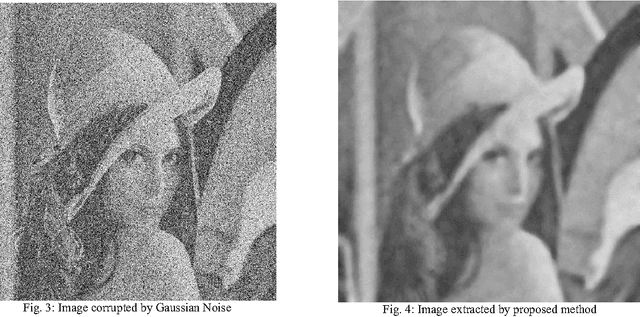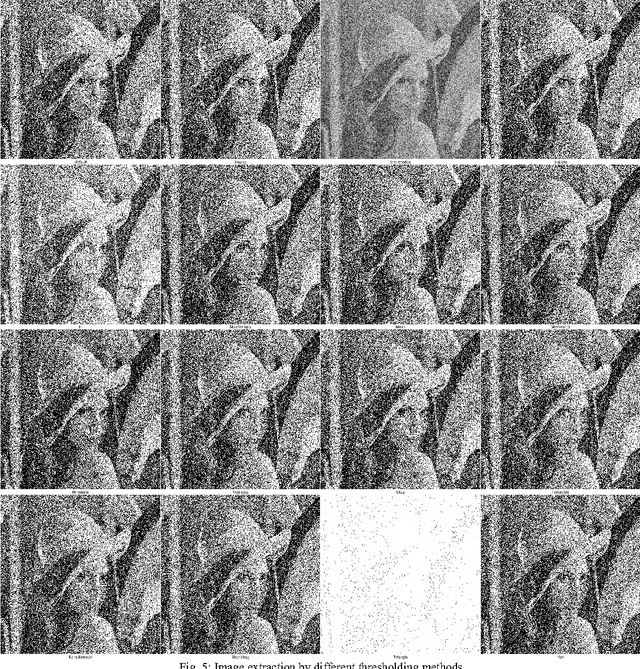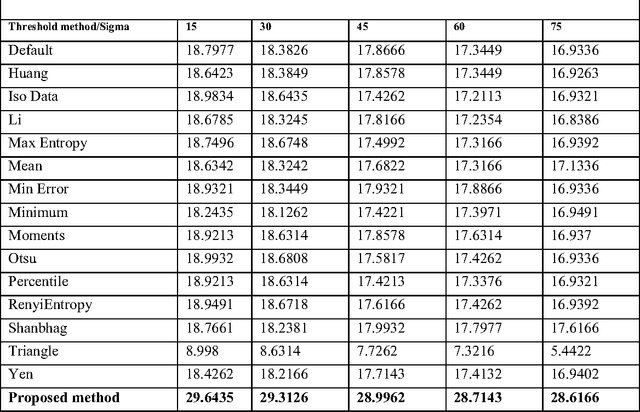Paramartha Dutta
Dept. of Computer & System Sciences, Visva-Bharati University
Real-Time Human Fall Detection using a Lightweight Pose Estimation Technique
Jan 03, 2024Abstract:The elderly population is increasing rapidly around the world. There are no enough caretakers for them. Use of AI-based in-home medical care systems is gaining momentum due to this. Human fall detection is one of the most important tasks of medical care system for the aged people. Human fall is a common problem among elderly people. Detection of a fall and providing medical help as early as possible is very important to reduce any further complexity. The chances of death and other medical complications can be reduced by detecting and providing medical help as early as possible after the fall. There are many state-of-the-art fall detection techniques available these days, but the majority of them need very high computing power. In this paper, we proposed a lightweight and fast human fall detection system using pose estimation. We used `Movenet' for human joins key-points extraction. Our proposed method can work in real-time on any low-computing device with any basic camera. All computation can be processed locally, so there is no problem of privacy of the subject. We used two datasets `GMDCSA' and `URFD' for the experiment. We got the sensitivity value of 0.9375 and 0.9167 for the dataset `GMDCSA' and `URFD' respectively. The source code and the dataset GMDCSA of our work are available online to access.
Vision-based Human Fall Detection Systems using Deep Learning: A Review
Jul 22, 2022



Abstract:Human fall is one of the very critical health issues, especially for elders and disabled people living alone. The number of elder populations is increasing steadily worldwide. Therefore, human fall detection is becoming an effective technique for assistive living for those people. For assistive living, deep learning and computer vision have been used largely. In this review article, we discuss deep learning (DL)-based state-of-the-art non-intrusive (vision-based) fall detection techniques. We also present a survey on fall detection benchmark datasets. For a clear understanding, we briefly discuss different metrics which are used to evaluate the performance of the fall detection systems. This article also gives a future direction on vision-based human fall detection techniques.
Evolution of Image Segmentation using Deep Convolutional Neural Network: A Survey
Feb 10, 2020



Abstract:From the autonomous car driving to medical diagnosis, the requirement of the task of image segmentation is everywhere. Segmentation of an image is one of the indispensable tasks in computer vision. This task is comparatively complicated than other vision tasks as it needs low-level spatial information. Basically, image segmentation can be of two types: semantic segmentation and instance segmentation. The combined version of these two basic tasks is known as panoptic segmentation. In the recent era, the success of deep convolutional neural network (CNN) has influenced the field of segmentation greatly and gave us various successful models to date. In this survey, we are going to take a glance at the evolution of both semantic and instance segmentation work based on CNN. We have also specified comparative architectural details of some state-of-the-art models and discuss their training details to present a lucid understanding of hyper-parameter tuning of those models. Lastly, we have drawn a comparison among the performance of those models on different datasets.
Advancements in Image Classification using Convolutional Neural Network
May 08, 2019



Abstract:Convolutional Neural Network (CNN) is the state-of-the-art for image classification task. Here we have briefly discussed different components of CNN. In this paper, We have explained different CNN architectures for image classification. Through this paper, we have shown advancements in CNN from LeNet-5 to latest SENet model. We have discussed the model description and training details of each model. We have also drawn a comparison among those models.
Convergence Analysis of Backpropagation Algorithm for Designing an Intelligent System for Sensing Manhole Gases
Jul 06, 2017



Abstract:Human fatalities are reported due to the excessive proportional presence of hazardous gas components in the manhole, such as Hydrogen Sulfide, Ammonia, Methane, Carbon Dioxide, Nitrogen Oxide, Carbon Monoxide, etc. Hence, predetermination of these gases is imperative. A neural network (NN) based intelligent sensory system is proposed for the avoidance of such fatalities. Backpropagation (BP) was applied for the supervised training of the neural network. A Gas sensor array consists of many sensor elements was employed for the sensing manhole gases. Sensors in the sensor array are responsible for sensing their target gas components only. Therefore, the presence of multiple gases results in cross sensitivity. The cross sensitivity is a crucial issue to this problem and it is viewed as pattern recognition and noise reduction problem. Various performance parameters and complexity of the problem influences NN training. In present chapter the performance of BP algorithm on such a real life application problem was comprehensively studied, compared and contrasted with the several other hybrid intelligent approaches both, in theoretical and in the statistical sense.
Identifying hazardousness of sewer pipeline gas mixture using classification methods: a comparative study
May 16, 2017



Abstract:In this work, we formulated a real-world problem related to sewer pipeline gas detection using the classification-based approaches. The primary goal of this work was to identify the hazardousness of sewer pipeline to offer safe and non-hazardous access to sewer pipeline workers so that the human fatalities, which occurs due to the toxic exposure of sewer gas components, can be avoided. The dataset acquired through laboratory tests, experiments, and various literature sources was organized to design a predictive model that was able to identify/classify hazardous and non-hazardous situation of sewer pipeline. To design such prediction model, several classification algorithms were used and their performances were evaluated and compared, both empirically and statistically, over the collected dataset. In addition, the performances of several ensemble methods were analyzed to understand the extent of improvement offered by these methods. The result of this comprehensive study showed that the instance-based learning algorithm performed better than many other algorithms such as multilayer perceptron, radial basis function network, support vector machine, reduced pruning tree. Similarly, it was observed that multi-scheme ensemble approach enhanced the performance of base predictors.
Performance Analysis Of Neuro Genetic Algorithm Applied On Detecting Proportion Of Components In Manhole Gas Mixture
Aug 15, 2012



Abstract:The article presents performance analysis of a real valued neuro genetic algorithm applied for the detection of proportion of the gases found in manhole gas mixture. The neural network (NN) trained using genetic algorithm (GA) leads to concept of neuro genetic algorithm, which is used for implementing an intelligent sensory system for the detection of component gases present in manhole gas mixture Usually a manhole gas mixture contains several toxic gases like Hydrogen Sulfide, Ammonia, Methane, Carbon Dioxide, Nitrogen Oxide, and Carbon Monoxide. A semiconductor based gas sensor array used for sensing manhole gas components is an integral part of the proposed intelligent system. It consists of many sensor elements, where each sensor element is responsible for sensing particular gas component. Multiple sensors of different gases used for detecting gas mixture of multiple gases, results in cross-sensitivity. The cross-sensitivity is a major issue and the problem is viewed as pattern recognition problem. The objective of this article is to present performance analysis of the real valued neuro genetic algorithm which is applied for multiple gas detection.
Gray Image extraction using Fuzzy Logic
Jun 20, 2012


Abstract:Fuzzy systems concern fundamental methodology to represent and process uncertainty and imprecision in the linguistic information. The fuzzy systems that use fuzzy rules to represent the domain knowledge of the problem are known as Fuzzy Rule Base Systems (FRBS). On the other hand image segmentation and subsequent extraction from a noise-affected background, with the help of various soft computing methods, are relatively new and quite popular due to various reasons. These methods include various Artificial Neural Network (ANN) models (primarily supervised in nature), Genetic Algorithm (GA) based techniques, intensity histogram based methods etc. providing an extraction solution working in unsupervised mode happens to be even more interesting problem. Literature suggests that effort in this respect appears to be quite rudimentary. In the present article, we propose a fuzzy rule guided novel technique that is functional devoid of any external intervention during execution. Experimental results suggest that this approach is an efficient one in comparison to different other techniques extensively addressed in literature. In order to justify the supremacy of performance of our proposed technique in respect of its competitors, we take recourse to effective metrics like Mean Squared Error (MSE), Mean Absolute Error (MAE), Peak Signal to Noise Ratio (PSNR).
Feature Based Fuzzy Rule Base Design for Image Extraction
Jun 16, 2012



Abstract:In the recent advancement of multimedia technologies, it becomes a major concern of detecting visual attention regions in the field of image processing. The popularity of the terminal devices in a heterogeneous environment of the multimedia technology gives us enough scope for the betterment of image visualization. Although there exist numerous methods, feature based image extraction becomes a popular one in the field of image processing. The objective of image segmentation is the domain-independent partition of the image into a set of regions, which are visually distinct and uniform with respect to some property, such as grey level, texture or colour. Segmentation and subsequent extraction can be considered the first step and key issue in object recognition, scene understanding and image analysis. Its application area encompasses mobile devices, industrial quality control, medical appliances, robot navigation, geophysical exploration, military applications, etc. In all these areas, the quality of the final results depends largely on the quality of the preprocessing work. Most of the times, acquiring spurious-free preprocessing data requires a lot of application cum mathematical intensive background works. We propose a feature based fuzzy rule guided novel technique that is functionally devoid of any external intervention during execution. Experimental results suggest that this approach is an efficient one in comparison to different other techniques extensively addressed in literature. In order to justify the supremacy of performance of our proposed technique in respect of its competitors, we take recourse to effective metrics like Mean Squared Error (MSE), Mean Absolute Error (MAE) and Peak Signal to Noise Ratio (PSNR).
 Add to Chrome
Add to Chrome Add to Firefox
Add to Firefox Add to Edge
Add to Edge